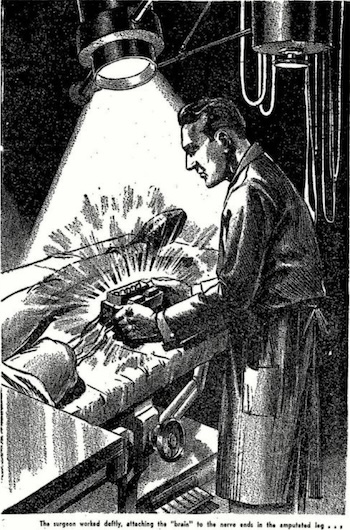Science Fiction
Dictionary
A B C D E F G H I J K L M N O P Q R S T U V W X Y Z
These Robot Legs Are Made For, Well, Walking

You can't have realistic Terminator robots without robotic legs that present accurate representations of human gait. University of Arizona engineers have done an amazing job of replicating human leg motions.
(Biologically accurate robot walking legs)
The body is based on principles derived from human muscular architecture, using muscles on straps to mimic agonist/antagonist muscle action as well as bifunctional muscles. Load sensors in the straps model Golgi tendon organs. The neural architecture is a central pattern generator (CPG) composed of a half-center oscillator combined with phase-modulated reflexes that is simulated using a spiking neural network. We show that the interaction between the reflex system, body dynamics and CPG results in a walking cycle that is entrained to the dynamics of the system. We also show that the CPG helped stabilize the gait against perturbations relative to a purely reflexive system, and compared the joint trajectories to human walking data.
Researchers hope that a better understanding of human locomotion will help develop new therapies for disabled people.
Update 28-Feb-2025: In his interesting 1949 story The Cybernetic Brain, science fiction writer Charles Recour describes a prosthetic leg with a brain:
It was an artificial leg, so cleverly and so artfully designed that it could hardly be told from a real one. Dr. Schmidt handed it to Larry. “Feel it,” he said, beaming, “it’s made of plastic and titanium. It doesn’t weigh very much.”Larry hefted the incredibly real contraption. To the touch, it felt as if it were made of human flesh. Its lightness was due to its being made of titanium, a metal as strong as steel, but much lighter. Its upper portion carried a web strap-and-belt arrangement for attaching, to the thigh.
('The Cybernetic Brain' by Charles Recour)"[Dr. Clydestone] will bring out the desired nerve endings from the end of the stump. He’ll connect them through platinum wires to little cable connectors... to seven nerve-endings protruding from his flesh, terminating, in ordinary electrical connections!"
But it was not the leg itself which was the real impressive agent; rather it was the electronic brain and the servo-mechanisms servicing it. Servomechanisms were simply electric or hydraulic motors whose motion was precisely controlled from a distance by electronic means.
The leg was to function, in a way, as a servo-mechanism operated by Larry’s brain, through the mediation of the electronic brain in the leg. It might be said that the artificial leg was a robot.
End update.
Via MedGadget.
Scroll down for more stories in the same category. (Story submitted 7/9/2012)
Follow this kind of news @Technovelgy.| Email | RSS | Blog It | Stumble | del.icio.us | Digg | Reddit |
Would
you like to contribute a story tip?
It's easy:
Get the URL of the story, and the related sf author, and add
it here.
Comment/Join discussion ( 0 )
Related News Stories - (" Robotics ")
Proof Of Robothood - Not A Person
'Who are you people? - Show 'em.' - James Cameron (1984).
Dancing Robots Taught Dance Moves
'A clockwork figure would be the thing for you...' Jerome K. Jerome, 1893.
Factory Humanoid Robots Built By Humanoid Robots
'...haven't you a section of the factory where only robot labor is employed?' - Isaac Asimov (1940).
Mornine Sales Robot
'Robot-salesmen were everywhere, gesturing...' - Philip K Dick, 1954.
Technovelgy (that's tech-novel-gee!) is devoted to the creative science inventions and ideas of sf authors. Look for the Invention Category that interests you, the Glossary, the Invention Timeline, or see what's New.
Science Fiction
Timeline
1600-1899
1900-1939
1940's 1950's
1960's 1970's
1980's 1990's
2000's 2010's
Current News
Natural Gait With Prosthetic Connected To Nervous System
'The leg was to function, in a way, as a servo-mechanism operated by Larry’s brain...'
Woman Marries Computer, Vonnegut's Dream Comes True
'Men are made of protoplasm... Lasts forever.'
Spidery 'Walk Me' Toyota Autonomous Wheel Chair Like Star Wars
Walk along with the emperor.
Dancing Robots Taught Dance Moves
'A clockwork figure would be the thing for you...'
Proof Of Robothood - Not A Person
'Who are you people? - Show 'em.'
Indonesian Clans Battle
'The observation vehicle was of that peculiar variety used in conveying a large number of people across rough terrain.'
The 'Last Mile' In China Crowded With Delivery Robots
Yes, it's a delivery robot. On wheels.
Tornyol Microdrone Kills Mosquitoes
'The real border was defended by... a swarm of quasi-independent aerostats.'
PLATO Spacecraft, Hunter Of Habitable Planets, Now Ready
'I ... set my automatic astronomical instruments to searching for a habitable planet.'
Factory Humanoid Robots Built By Humanoid Robots
'...haven't you a section of the factory where only robot labor is employed?'
iPhone Air Fulfils Jobs' Promise From 2007 - A Giant Screen!
'... oblongs were all over the floor and surfaces.'
ChatGPT Now Participates in Group Chats
'...the city was their laboratory in human psychology.'
iPhone Pocket All Sold Out!
'A long, strong, slender net...'
Did The Yautja Have These First?
What a marvel of ingenuity the little device was!
Jetson ONE Air Races Begin, Can Air Polo Be Far Behind?
'If you're one of those rarities who haven't attended a rocket-polo "carnage", let me tell you it's a colorful affair.'
Will Space Stations Have Large Interior Spaces Again?
'They filed clumsily into the battleroom, like children in a swimming pool for the first time, clinging to the handholds along the side.'

